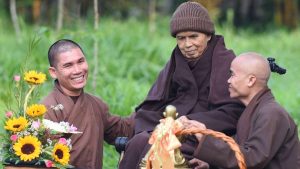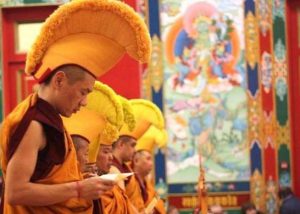I have written previously about connecting with the Lama through the practice of guru yoga, especially when they have attained parinirvana or left their human body. The death of one’s Lama can be an intense and heartbreaking experience, even though our practice, devotion, and reliance remain strong. As practitioners, we connect with our living Lamas through prayer, practice, service, and recalling their qualities. This connection transcends the bardo of life-into-death, and it is important for new and longtime students to practice guru yoga. Embarking on the Dharma path, we engage in the process of choosing a teacher.
As a beginner, we seek out an authentic teacher, then ideally take time to “interview” them. Like any new relationship, we gauge their actions and qualities, their habits and integrity, over time. Once we establish a basis of trust, then reliance and devotion can blossom. Sometimes it is more immediate—an inner knowing or a felt sense of past-life connection. For established practitioners, guru yoga becomes effortless, blending our mind with the non-conceptual dharmakaya, through the nirmanakaya of our teacher. We pray that at the time of our own death, we will be united with the mind-stream of our Lama. And until then, we wish to emulate and embody their qualities. Therefore, we practice guru yoga.
The Lama is a worthy guide, a bridge linking seen and unseen worlds. When we have a positive karmic connection based on mutual trust, then authentic love can arise between the student and teacher—a love beyond sentimentality, attachment, or projection. This authentic, unbiased, or uncorrupted love and trust stands in opposition to a projection, quid pro quo, or the corrupted kind of dependency that we experience in day-to-day relations. In ordinary relationships with other human beings, we experience the gross or subtle corruption, if you will, of a business transaction. We want love in exchange for love, or acceptance, company, entertainment. By contrast, a guru is present whether they and the student have any affinity, and even when they are no longer in their physical form. Kirtan master Krishna Das describes this beautifully as:
Guru is not a body; Guru, God, Self, are one thing. When you meet a being who is your guru, it’s not the physical body that is the guru . . . it is what’s in that body, the being that’s inhabiting that body, and if it’s a real guru, that never dies.*
Of course, spiritual teachers themselves are also human beings with personalities, flaws, and characteristics. Once we have done our homework or due diligence in examining the guru’s qualities and actions, we rely on their innate, genuine, pure being that shows us our pure nature too, in life, in death, and beyond.
We pick wisely when we choose a teacher, because we want to learn—and unlearn—what is important to us at the deepest level. We hope to learn that which is going to be meaningful—not only for this lifetime, but through death and potentially into the next lifetime. This is not something that we do casually. And we must be psychologically stable enough to rely on our own intuition, intelligence, and common sense. Hopefully, we would give as much attention to our choice of guru as we would to someone we are going to spend our life with as a partner or an intimate friend, even more so. A spiritual teacher serves to guide us not only in this physical realm but beyond it into the most important aspects of our being:
The special quality of a good Lama is that he or she sees your Buddha nature, that which you don’t see in yourself. Trusting in your Lama is trusting in their view about you. Feeling devotion toward your Lama, you look in their eyes and see your own Buddha nature reflected. Because your Lama is this mirror, the more you develop trust in your teacher, the more you can trust in your Buddha nature. This is a case of love; a true, pure love.**
And so this guru yoga, this joining of mind with mind-stream, can be described with the classic metaphor of an ice cube melting in warm water: effortlessly, naturally, without contrivance or forcefulness, by simply relaxing a frozen state and the warm water being itself. The ice cube relinquishes resistance or hard-heartedness, the frozen feeling, and melts into the space of the teacher’s mind-stream. The teacher’s mind-stream, of course, is not particular to them. It is the space of the dharmakaya, the space, breadth, and timeless awareness of pure genuine being-ness beyond words.
The lineage itself and all the great teachings are tools and supports, but they are not particularly necessary except as skillful methods to arrive back to the genuine state we never left. It is a paradox, without need for philosophical examination or resolution. It is even not particular to Buddhism. Buddhism has no exclusive ownership or cornered market on awareness, expansiveness, and the limitless nature of being. This is the birthright and inheritance of all sentient beings! The guru is simply one who reminds us of this, which we have momentarily forgotten. It is from selfless love and compassion that they hold up this mirror and provide an example. And it is for this we have trust and devotion to the guru:
Pure love is a very pure state of mind where the sense of self is reduced, and it is much easier to catch a glimpse of the true nature of the mind beyond concepts. If we look very well to the word devotion in the context of Buddhism, we will be much less afraid of having devotion. Many people think that devotion is a kind of mindless surrender. Of course, there is a level of surrender, but it is based on trust.***
When we engage in guru yoga, literally yoking or joining our mind with the mind-stream of the Lama happens in many ways. Most importantly, it happens by a kind of surrender on our part of our hard-headedness and our doubt. We offer up our doubt, or our resistance, about our true nature itself. As one Dharma teaching says: we turn the dogs of doubt on doubt itself. And rely on our inner knowing, which blossoms through a genuine connection with a qualified, trusted, realized guide.
* Krishna Das Teaching in Berlin, Germany, 7/17/2013 [Track 1, 3 minutes] (Spotify)
** Personal conversation with Lama Gyurme, Guhya Mantrika Community, Alcácer do Sal, Portugal, November 2022. Guhya Mantrika Community
*** ibid.
Related features from BDG
Who is the Guru? Accessing Inner Wisdom When the Teacher Has Passed
Book Review: Lama Shenpen Hookham’s Keeping the Dalai Lama Waiting & Other Stories
Do I Need a Teacher to Practice Meditation?
Gaze of a Guru: Celebrating the Teacher-Student Relationship
The Role of Prayer
















